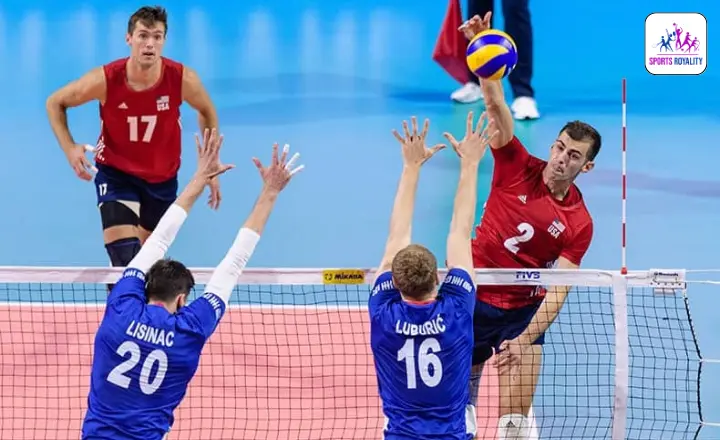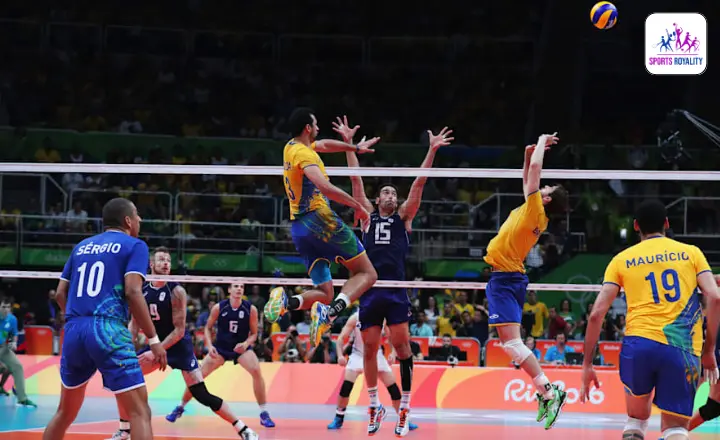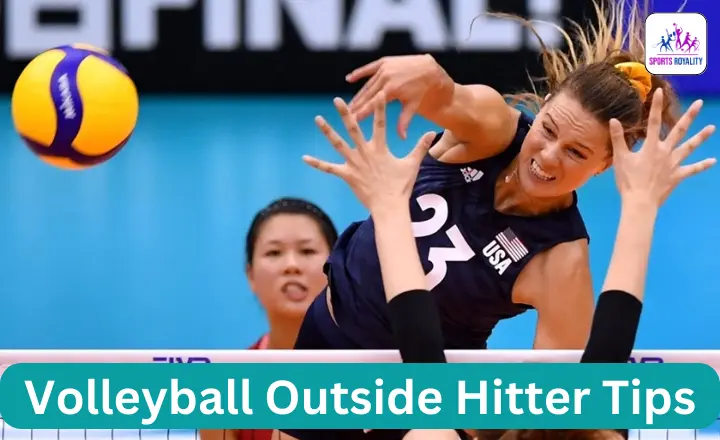Whether you’re a seasoned volleyball player or just starting, mastering the art of being an outside hitter is crucial for success. As one of the most dynamic positions in volleyball, outside hitters play a pivotal role in offense and defense. From powerful spikes to precise digs, these players must possess unique skills and strategies to dominate the game. We have gathered 16 expert Volleyball Outside Hitter Tips from top coaches and players to help you enhance your performance. Whether improving your footwork, perfecting your timing, or developing effective hitting techniques, these invaluable insights will undoubtedly take your game to new heights.
Practice Tooling The Ball Off The Block:
You won’t always have the luxury of a perfect set with no block in your way. That’s where tooling comes in handy.
Instead of trying to power through the block, take advantage of the opportunity by aiming for the outer edge of the seam. By doing so, you can use the block to your advantage and earn valuable points for your team. Whether it’s a well-executed tip or a clever push off the blocker’s hands, these techniques can give you better control over where the ball lands on their side of the court.
Gather three players for practice sessions focused on using different shots against various blocks to hone this skill. Aim high off their fingers when faced with a solid setup and swing aggressively to achieve maximum effect.
The more you practice tooling off the block in different scenarios, the easier it will become during actual games. Your teammates will be inspired by your ability to turn what could have been a stuffed block into a strategic point-scoring move.
Mastering tooling techniques as an outside hitter adds depth to your game and keeps opponents guessing. It allows you to stay agile and adaptable when faced with challenging blocks while giving you an upper hand in exploiting their weaknesses.

Don’t Be Afraid To Tip The Ball:
While there’s no denying the power and excitement of a thunderous spike, great outside hitters understand that there are times when finesse can be just as effective. Weak outside hitters often rely solely on their power, but great players know how to mix things up and keep their opponents guessing.
One of the tools in an exceptional outside hitter’s toolbox is the ability to tip the ball strategically. Players can catch their opponents off guard and earn valuable points for their team by using a quick and unexpected touch over or around the block. This unconventional move surprises committed blockers and creates opportunities for unpredictable angles of attack, making it harder for defenders to predict where to position themselves.
Tipping the ball at the last second can prove devastating against opponents heavily focused on blocking. When a blocker fully commits to stopping a powerful spike, they leave open spaces in other court areas, which can be exploited with a well-executed tip. This type of play requires immense timing and finesse, which sets extraordinary outside hitters apart from average ones.
So next time you find yourself in a game situation where hitting hard may not be your best option, don’t be afraid to tip instead. Trust your instincts as an outside hitter, and consider incorporating this underutilized technique into your arsenal.
Spend A Lot More Time Passing:
Passing is equally important and often overlooked. A strong passing game sets up your team for successful attacks and allows you to be in the best position to hit.
To improve your passing, focus on your footwork and body positioning. Ensure you are always moving towards the ball and getting behind it to create a solid platform with your arms. Practice different types of passes, such as forearm and overhead passes, to become comfortable with both techniques. Work on your communication skills with your teammates, as effective communication is crucial for successful passing.
You will become a more well-rounded player and significantly impact your team’s success by dedicating more time to improving your passing skills. So don’t neglect this aspect of the game, and prioritize it in your training sessions.
Aim For The International Hitting Zone:
The most important volleyball outside hitter tips I can give you is to aim for the international hitting zone. The international hitting zone is a specific area on the court where you have the highest chance of scoring points. It is located between the antenna and the top of the block, and it’s crucial to hit your spikes within this zone.
Focus on your approach and timing when aiming for the international hitting zone. A strong approach with explosive footwork will help you generate power and momentum for your spike.
Timing is key to connecting with the setter’s set at its peak. By mastering these aspects, you can consistently hit within the international hitting zone and increase your chances of scoring points for your team.

Increase Your Spike Height:
You can follow a few tips to increase your spike height as an outside hitter in volleyball.
- Focus on your approach and timing. A well-timed approach with explosive speed can help you generate more power and height in your spike. Make sure to use your arms and legs together for maximum force.
- Work on your jump technique. Practice jumping off both feet and aiming as high as possible using proper arm swing and body positioning. Strengthening your leg muscles through exercises like squats and lunges can also contribute to a higher vertical jump.
- Pay attention to your contact point with the ball. Aim to contact the ball at its highest point, allowing you to hit it downwards with more force. This requires good anticipation and quick reaction time.
Remember that increasing spike height takes time and practice. Consistency is key, so keep working on these tips during training sessions and games to see improvement over time.
Make Good Use Of The Roll Shot:
A finesse shot can deceive the opposing blockers and score points. There are a few key tips to remember to make good use of the roll shot.
- Timing is crucial when executing a roll shot. As an outside hitter, you need to wait until the blockers commit to jumping before using this shot. This allows you to hit the ball low and short over their hands, making it difficult for them to defend.
- Focus on your technique when performing the roll shot. The key is to contact the ball with an open hand and a soft touch. Aim for a downward trajectory, as this will help the ball land close to the net and allow your teammates an easy attack or block.
- Practice is essential in perfecting your roll shot. Work on your timing and technique during training sessions and scrimmages. With enough repetition, you will become more comfortable and confident utilizing this skill during games. Remember that consistency is key to making each roll shot accurate and effective.
The roll shot can be a powerful weapon for outside hitters in volleyball.
Talk To Your Middle Blocker More:
Communication is key in any team sport, and volleyball is no exception. By constantly communicating with your middle blocker, you can develop a strong understanding of each other’s movements and intentions on the court.
Talking to your middle blocker allows you to coordinate your attacks more effectively. You can discuss strategies, set plays, and specific signals to help you anticipate each other’s moves. This level of communication will enhance your performance as an outside hitter and improve the overall efficiency and effectiveness of your team’s offense.
Talking to your middle blocker during gameplay helps create a positive and supportive atmosphere on the court. It builds trust and camaraderie among teammates, leading to better teamwork and results.
Practice Hitting Release Balls:
Release balls are sets released earlier than usual, forcing the hitter to adjust their timing and footwork. This practice helps improve players’ ability to read the game and make split-second decisions.
To excel at hitting release balls, it is important to focus on three key areas:
- Anticipation
- Footwork
- Arm Swing Technique
Anticipating where the ball will be released allows the hitter to position themselves correctly and time their approach accordingly. Working on quick and precise footwork helps adjust to the ball’s early release. Mastering proper arm swing technique ensures maximum power and accuracy when hitting release balls.
Run Faster Attacks:
Run Faster Attacks means the setter will push the ball quicker and in a lower arc to create better offense. Big looping sets are not commonly used in high-level volleyball as they slow down the game. It is crucial for you as an outside hitter to be prepared for these fast-paced attacks.
The key advantage of a quicker offense is that it makes it harder for the block to get into position. By attacking the second step of your approach, known as a 2nd step attack, you can catch the opposing block off guard and increase your chances of scoring points. Timing this correctly can be challenging and may not be ideal for beginners. Nonetheless, as you advance in the sport, consider this technique and practice diligently to perfect your timing.
Running faster attacks as an outside hitter requires skill and practice. Understanding the dynamics of quick offense, such as lower arc sets and 2nd step attacks, can give you an edge over your opponents. As you improve in volleyball, focus on honing your timing and speed to become a formidable force on the court.
Practice Block To Spike Transition:
The block to spike transition is communication with your setter. To effectively execute an attack after blocking, it’s important to establish clear signals or cues with your setter. It can be done through eye contact, hand signals, or verbal communication. Communicating effectively ensures that you and your setter are on the same page and ready to deliver a successful spike.
Practicing transitions regularly during training sessions is key to improving this vital aspect of an outside hitter’s game. Incorporate drills specifically on transitioning from a block position into hitting various sets from different angles and distances from the net. Try practicing these transitions at game-like speeds to enhance reaction time and decision-making abilities during real matches.
Practice Hitting The Pipe:
The pipe is a back-row attack that involves the outside hitter jumping from behind the ten-foot line and hitting the ball toward the middle of the court. This strategic move can catch opponents off guard, opening up new angles and putting pressure on their defense.
To practice hitting the pipe, focus on timing and footwork. You’ll need to work on your approach and ensure you take off from behind the ten-foot line. It’s crucial to time your jump correctly to generate enough power and hit the ball at its highest point. Pay attention to your footwork as you approach; make sure each step is deliberate and prepares you for a strong takeoff.
Communicating with your setter is another important aspect of executing a successful pipe attack. Timing is key in this play, so both players must be on the same page. Communicate your intentions clearly with hand signals or verbal cues to ensure a smooth connection with your setter.
Incorporating the pipe into your arsenal as an outside hitter will add versatility to your game. Practice consistently, focus on timing and footwork, communicate effectively with your setter, and watch as this powerful attacking option helps lead your team to victory.
Use Side Spin When Spiking:
Using side spin when spiking as an outside hitter can be a valuable technique to add variation and deception to your attacks. By applying side spin to the ball, you can make it more challenging for the opposing team’s defense to predict the trajectory and direction of your spike. It can give you an advantage by catching them off guard and increasing the chances of scoring points.
To execute a spike with side spin, focus on contacting the ball slightly off-center, towards the direction you want the ball to curve. For example, if you want the ball to curve towards the right, contact it slightly towards the left side of your hand. Try to generate rotational force by snapping your wrist at contact. This will help impart more spin on the ball and increase its curving effect.
Identify Weaknesses & Exploit Aggressively:
Observe your opponents during the game to identify weaknesses and exploit them aggressively. Pay close attention to their positioning, footwork, and movements. Look for any patterns or tendencies they may have when defending against attacks from the outside hitter position.
Once you have identified a weakness in your opponent’s defense, it is important to exploit it aggressively. This can be done by adjusting your attack strategy accordingly. For example, if you notice that your opponent struggles with high balls or has difficulty defending against cross-court shots, you can focus on using these techniques more frequently during the game.
By informing your setter or other teammates about your identified weakness, they can help set up plays and strategies targeting it. Working together as a team will increase your chances of success in exploiting weaknesses and gaining an advantage over your opponents.
Aspire To Be Extremely Consistent:
It holds even greater importance for a position like an outside hitter. Your team relies on you to deliver powerful and accurate hits consistently throughout the game.
To achieve consistency, focus on developing a strong foundation of fundamental skills such as footwork, timing, and technique. Practice your approach and hitting mechanics diligently to ensure that your swings are consistent every time. Work on your mental game by staying focused and maintaining a positive mindset. Consistency is not just about physical abilities. It also requires mental discipline and focus.
Improve Your Transition Footwork:
They allow you to quickly move from defense to offense and get in position for passing and spiking the ball. Your timing could be off without proper footwork, resulting in missed opportunities and a weaker overall performance.
To improve your transition footwork, studying the techniques of expert players can be helpful. In a video demonstration, you can see how they seamlessly shift their weight from one foot to the other, using quick steps to get into position and set up for a powerful attack. Pay attention to their balance and agility as they make those split-second adjustments.
While having an ideal footwork technique is important, it’s also crucial to understand that not every situation on the court will allow for perfect execution. Sometimes, you’ll have limited time when receiving the serve or making a pass. In these scenarios, adjusting your footwork on the fly becomes essential. Stay light on your feet and ready for any direction change that might be necessary. Adaptability is key when it comes to making successful transitions during gameplay.
Wear The Right Shoes:
Having the right shoes can make a significant difference in your game. Not only do they provide essential support and stability, but they also enhance your overall performance on the court. One vital tip is to find a shoe that offers excellent grip. They will help you with quick movements and sudden changes in direction, allowing you to maintain control during high-intensity plays.
Another important aspect to consider when choosing volleyball shoes as an outside hitter is their versatility. Look for shoes built for indoor and outdoor play, allowing you to adapt effortlessly to different court conditions. Investing in a shoe that offers cushioning and shock absorption is also crucial to minimize the impact on your feet and joints while jumping and landing repeatedly throughout the game.
Wearing the right shoes as an outside hitter can significantly improve your performance on the volleyball court. Look for shoes with good grip, versatility for different playing surfaces, and adequate cushioning.
Final Words For Volleyball Outside Hitter Tips:
These 16 expert volleyball outside hitter tips can greatly improve your skills and overall performance on the court. From mastering your footwork to developing a strong arm swing, each tip offers valuable insights that can take your game to the next level.
Remember to focus on your positioning and communication with your teammates, maintaining a positive attitude, and staying mentally prepared. With consistent practice and dedication, you have the potential to become a formidable outside hitter. So go out there, put these tips into action, and dominate the volleyball court.
FAQ’s:
How to become a better hitter in Volleyball
To become a better hitter in volleyball, there are several key areas to focus on. Work on your technique and form. They include having a strong approach, proper arm swing, and good footwork. Practice these skills consistently to develop muscle memory and improve your timing.
How to get better at hitting in Volleyball
To improve your hitting skills in volleyball, focus on three key areas: technique, strength, and practice. Work on your technique by ensuring proper arm swing and footwork. Practice hitting with a high elbow position and snap your wrist at the point of contact to generate power and accuracy. Pay attention to your footwork and approach to maximize your jump and timing.

